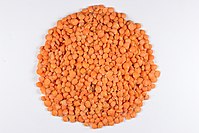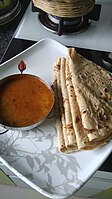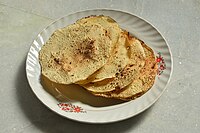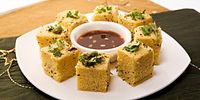| This article needs additional citations for verification. Please help improve this article by adding citations to reliable sources. Unsourced material may be challenged and removed. Find sources: "Dal" – news · newspapers · books · scholar · JSTOR (March 2014) (Learn how and when to remove this message) |
 Lentils are a staple ingredient in cuisines from the Indian subcontinent. Clockwise from upper right: split red lentils, common green whole lentils, and Le Puy lentils. Whole lentils have their outer coats visible. Lentils are a staple ingredient in cuisines from the Indian subcontinent. Clockwise from upper right: split red lentils, common green whole lentils, and Le Puy lentils. Whole lentils have their outer coats visible. | |
| Alternative names | Daal, dail, dahl, parripu,pappu, ooti |
|---|---|
| Region or state | Indian subcontinent |
| Main ingredients | Lentils, peas or beans |
In Indian cuisine, dal (also spelled daal or dhal pronunciation: [d̪aːl]), parippu, pappu, or paruppu are dried, split pulses (e.g., lentils, peas, and beans) that do not require soaking before cooking. India is the largest producer of pulses in the world. The term is also used for various soups prepared from these pulses. These pulses are among the most important staple foods in South Asian countries, and form an important part of the cuisines of the Indian subcontinent.
Etymology
The word dāl (dal) derives from the Sanskrit verbal root dal- "to split", which is inherited from Proto-Indo-European *delh₁- "to split, divide".
History
Lentils are among the most ancient cultivated foods; they have been found in human settlements dating back to the Bronze Age. Researchers have dated the preparation and cooking of split dal as far back as 800-300 BC.
Dal as a staple food has been mentioned in many ancient religious texts, including the Yajurveda, the Mahayana Buddhist Laṅkāvatāra Sūtra, and the Bible:
May for me strength, righteousness, milk, sap, ghee, honey, eating and drinking in company, ploughing, rain, conquest, victory, wealth, riches, prosperity, prospering, plenteousness, lordship, much, more, fun, fuller, imperishableness, bad crops, food, freedom from hunger, rice, barley, beans, sesame, kidney beans, vetches, wheat, lentils, millet, Panicum miliaceum, Panicum frumentaceum, and wild rice (prosper through the sacrifice).
— Yajurveda, Kanda IV, Prapathaka VII, trans. Arthur Berriedale Keith
Now, Mahāmati, the food I have permitted is gratifying to all wise people but is avoided by the unwise; it is productive of many merits, it keeps away many evils; and it has been prescribed by the ancient Rishis. It comprises rice, barley, wheat, kidney beans, beans, lentils, etc., food prepared with these is proper food.
— Laṅkāvatāra Sūtra 249-250, trans. D. T. Suzuki
Then Jacob gave Esau some bread and some lentil stew. He ate and drank, and then got up and left. So Esau despised his birthright.
— Genesis 25:33, New International Version
Use


Dal are often prepared in three different forms:
- Unhulled and whole, known as sabut ('whole' in Hindi), such as sabut urad dal or mung sabut;
- Unhulled and split, known as chilka ('shell' in Hindi), such as chilka urad dal or mung dal chilka;
- Hulled and split, known as dhuli ('washed' in Hindi), e.g. urad dhuli, or mung dhuli.
The hulling of a pulse is intended to improve digestibility and palatability. It also affects the nutrition provided by the dish, significantly increasing protein and reducing dietary fibre content. Pulses with their outer hulls intact are also quite popular in the Indian subcontinent as the main cuisine. Over 50 different varieties of pulses are known in the Indian subcontinent.
Dal is frequently eaten with flatbreads, such as rotis or chapatis, or with rice. The latter combination is called dal bhat in Nepali, Gujarati, and various other Indian languages. In addition, certain types of dal are fried, salted, and eaten as a dry snack, and a variety of savory snacks are made by frying a paste made from soaked and ground dals in different combinations, to which other ingredients, such as spices and nuts (commonly cashews) may be added.
Dal preparations are eaten with rice, chapati and naan on the Indian subcontinent. The manner in which it is cooked and presented varies by region. In South India, dal is often called "paruppu". It is primarily used to make a dish called sambar. It is also used to make parippu that is mixed with charu and rice. Ground chana dal is used to make a paste called besan, which is used in the preparation of many dishes including bhaji and Mediterranean dishes like farinata.
Preparation

Most dal recipes are quite simple to prepare. The standard preparation begins with boiling a variety of dal (or a mix) in water with some turmeric, salt to taste, and then adding a fried garnish at the end of the cooking process. In some recipes, tomatoes, kokum, unripe mango, jaggery, or other ingredients are added while cooking the dal, often to impart a sweet-sour flavour.
The fried garnish for dal goes by many names, including chaunk, tadka/tarka, bagar, fodni, and phoran. The ingredients in the chaunk for each variety of dal vary by region and individual tastes. The raw spices (more commonly cumin seeds, mustard seeds, asafoetida, and sometimes fenugreek seeds and dried red chili pepper) are first fried for a few seconds in the hot oil on medium/low heat. This is generally followed by ginger, garlic, and onion, which are generally fried for 10 minutes. After the onion turns golden brown, ground spices (turmeric, coriander, red chili powder, garam masala, etc.) are added. The chaunk is then poured over the cooked dal.
Nutrition
See also: Legume § Nutritional valueAs the main ingredient of dal is the pulse used, it gains much of its nutritional properties from the pulse.
| Item | Water | Protein |
|---|---|---|
| Cooked rice | 68.4 | 2.7 |
| Cooked dal | 68.5 | 11.9 |
| Roti | 33.5 | 11.5 |
| Cooked soybean | 62.5 | 16.6 |
| Boiled egg | 74.6 | 12.6 |
| Cooked chicken | 64.3 | 25.3 |
| Vitamins | Minerals | |||||||||||||||||||||||
|---|---|---|---|---|---|---|---|---|---|---|---|---|---|---|---|---|---|---|---|---|---|---|---|---|
| Food | Protein | A | B1 | B2 | B3 | B5 | B6 | B9 | B12 | Ch. | C | D | E | K | Ca | Fe | Mg | P | K | Na | Zn | Cu | Mn | Se |
| Cooking Reduction % | 10 | 30 | 20 | 25 | 25 | 35 | 0 | 0 | 30 | 10 | 15 | 20 | 10 | 20 | 5 | 10 | 25 | |||||||
| Rice | 14 | 0 | 12 | 3 | 11 | 20 | 5 | 2 | 0 | 0 | 0 | 0 | 0 | 0 | 1 | 9 | 6 | 7 | 2 | 0 | 8 | 9 | 49 | 22 |
| Wheat | 27 | 0 | 28 | 7 | 34 | 19 | 21 | 11 | 0 | 0 | 0 | 0 | 0 | 0 | 3 | 20 | 36 | 51 | 12 | 0 | 28 | 28 | 151 | 128 |
| Soybean | 73 | 0 | 58 | 51 | 8 | 8 | 19 | 94 | 0 | 24 | 10 | 0 | 4 | 59 | 28 | 87 | 70 | 70 | 51 | 0 | 33 | 83 | 126 | 25 |
| Toor Dal (split pigeon pea) | 43 | 1 | 43 | 11 | 15 | 13 | 13 | 114 | 0 | 0 | 0 | 0 | 0 | 0 | 13 | 29 | 46 | 37 | 40 | 1 | 18 | 53 | 90 | 12 |
| Urad Dal (black lentil) | 45 | 0 | 24 | 21 | 10 | 0 | 22 | 54 | 0 | 0 | 0 | 0 | 0 | 0 | 14 | 58 | 75 | 54 | 21 | 3 | 35 | 0 | 0 | 0 |
| Mung Dal (mung bean) | 43 | 0 | 54 | 19 | 15 | 38 | 29 | 156 | 0 | 0 | 6 | 0 | 3 | 9 | 13 | 52 | 53 | 52 | 27 | 0 | 28 | 0 | 49 | 0 |
| Chana Dal (chickpea) | 25 | 1 | 32 | 12 | 8 | 16 | 27 | 139 | 0 | 17 | 7 | 0 | 0 | 0 | 11 | 35 | 29 | 37 | 25 | 24 | 23 | 42 | 110 | 12 |
Note: All nutrient values including protein are in %DV per 100 grams of the food item. Significant values are highlighted in light gray color and bold letters. Cooking reduction = % Maximum typical reduction in nutrients due to boiling without draining for ovo-lacto-vegetables group.
Common ingredients
- Pigeon pea, i.e., yellow pigeon pea, is available either plain or oily. It is called toor dal in Hindi. It is called thuvaram paruppu in Tamil Nadu, thuvara parippu in Kerala and is the main ingredient for the dish sambar. In Karnataka, it is called togari bele and is an important ingredient in bisi bele bath. It is called kandi pappu in Telugu and is used in the preparation of a staple dish pappu charu. It is also known as arhar dal in northern India.
- Chana dal is produced by removing the outer layer of black chickpeas and then splitting the kernel. Although machines can do this, it can be done at home by soaking the whole chickpeas and removing the loose skins by rubbing. In Karnataka it is called kadle bele. Other varieties of chickpea may be used, e.g., kabuli dal.
- Yellow split peas are very prevalent in the Indian communities of Guyana, Fiji, Suriname, Jamaica, South Africa, Mauritius, Trinidad and Tobago, and are popular amongst Indians in the United States as well as India. There, it is referred to generically as dal and is the most popular dal. It is prepared similarly to dals found in India, but may be used in recipes. The whole dried pea is called matar or matar dal in India. The whole dried yellow pea is the main ingredient in the common Bengali street food ghugni.
- Split mung beans (mung dal) is by far the most popular in Bangladesh and West Bengal (moog dal, (মুগ ডাল)). It is used in parts of South India, such as in the Tamil dish ven pongal. Roasted and lightly salted or spiced mung bean is a popular snack in most parts of India.
- Urad dal, sometimes referred to as "black gram", is a primary ingredient of the south Indian dishes idli and dosa. It is one of the main ingredients of East Indian (Odia and Bengali or Assamese) bori, sun-dried dumplings. The Punjabi version is dal makhani. It is called uddina bele in Karnataka, biulir dal in Bengali. It is rich in protein.
- Masoor dal: split red lentils. In Karnataka, it is called kempu (red) togari bele.
- Rajma dal: split kidney beans.
- Mussyang is made from dals of various colours found in various hilly regions of Nepal.
- Panchratna dal (Hindi) ("five jewels") is a mixture of five varieties of dal, which produces a dish with a unique flavour.
- Navrangi dal is a lesser known Dal variety from Himachal Pradesh. It is mostly cultivated in Himachal and is multicoloured.
- Moth bean: is an Indian dal main ingredient for popular Indian snack bikaneri bhujia and Maharashtrian snacks misal and usal.
- Pulses may be split but not hulled; they are distinguished from hulled dals by adding the word chilka (skin).
Gallery
-
 Split red lentil seeds
Split red lentil seeds
-
Split pigeon pea, commonly used in dal
-
 Dal tadka and chapati
Dal tadka and chapati
-
 Plain dal served with roti, sauteed okra and green-mango pickle.
Plain dal served with roti, sauteed okra and green-mango pickle.
-
 Idlis, steamed rice and black lentil cakes
Idlis, steamed rice and black lentil cakes
-
 Dal tadka served with rice and papadam, a staple meal in the Indian subcontinent
Dal tadka served with rice and papadam, a staple meal in the Indian subcontinent
-
 Fire-toasted papads, using lentils as a major ingredient
Fire-toasted papads, using lentils as a major ingredient
-
 Dhokla, a steamed, fermented chana dal snack using lentils
Dhokla, a steamed, fermented chana dal snack using lentils
See also
- Dal bhat
- Dal bati churma
- Dal biji
- Ezogelin soup
- Fasole bătută
- Lentil soup
- Monggo (Philippine version of dal)
- Pea soup
References
- "20 Dhal recipes". BBC Good Food. Immediate Media Company. Retrieved 19 April 2023.
- "FAO in India". Retrieved 2 September 2020.
- Davidson, Alan; Jaine, Tom (2014). "Dal". The Oxford Companion to Food. Oxford University Press. p. 246. ISBN 9780199677337.
- John Ayto (2012). The Diner's Dictionary: Word Origins of Food and Drink. Oxford University Press. p. 116. ISBN 978-0-19-964024-9.
- Williams, Monier (1899). A Sanskrit–English Dictionary. Oxford: Clarendon Press. p. 471. OCLC 458052227.
- Mallory, J. P.; Adams, D. Q. (2006) The Oxford Introduction to Proto-Indo-European and the Proto-Indo-European World (Oxford Linguistics), New York: Oxford University Press, page 372
- Rix, Helmut, editor (2001) Lexikon der indogermanischen Verben (in German), 2nd edition, Wiesbaden: Dr. Ludwig Reichert Verlag, page 114
- Pokorny, Julius (1959) Indogermanisches etymologisches Wörterbuch (in German), volume 1, Bern, München: Francke Verlag, page 0194
- "Lentil". Encyclopedia Britannica.
- Agrawal, Chitra (22 November 2021). "What is dal?". Bon Appetit.
- Berriedale Keith, Arthur. The Yajur Veda (Taittiriya Sanhita).
- Suzuki, D.T. (1999). The Laṅkāvatāra Sūtra: A Mahāyāna Text.
- Ottolenghi, Yotam. "Pulse points: Yotam Ottolenghi's dried bean and pea recipes". The Guardian. Retrieved 29 September 2015.
- "Sample recipe for Chilka Urad dhal, split unhulled urad".
- Mehta, Nita (2006). Dal & Roti. SNAB. p12. ISBN 978-81-86004-06-7.
- Wang, N.; Hatcher, D.W.; Toews, R.; Gawalko, E.J. (2009). "Influence of cooking and dehulling on nutritional composition of several varieties of lentils (Lens culinaris)". LWT - Food Science and Technology. 42 (4): 842–848. doi:10.1016/j.lwt.2008.10.007.
- Cloake, Felicity. "How to make the perfect onion bhajis". The Guardian.
- Cloake, Felicity (2 June 2011). "How to cook perfect dal". The Guardian.
- "Nutrition Facts". self.com. Retrieved 29 September 2015.
- "Lentils, mature seeds, cooked, boiled, without salt Nutrition Facts & Calories". nutritiondata.self.com.
- "Food Composition Databases Show Foods -- Bread, chapati or roti, plain, commercially prepared". ndb.nal.usda.gov. Archived from the original on 10 March 2016. Retrieved 5 November 2015.
- "Nutrition Facts". self.com. Retrieved 29 September 2015.
- "Nutrition Facts". self.com. Retrieved 29 September 2015.
- "Nutrition Facts". self.com. Retrieved 29 September 2015.
- "Nutrition Facts". self.com. Retrieved 29 September 2015.
- "Lentils, mature seeds, cooked, boiled, without salt per 100 g". Nutritiondata.com by Conde Nast; from USDA National Nutrient Database, Standard Reference 21. 2014. Retrieved 29 September 2015.
- "Show Nutrients List". usda.gov. Archived from the original on 3 April 2019. Retrieved 29 September 2015.
- "USDA Table of Nutrient Retention Factors, Release 6" (PDF). USDA. USDA. December 2007.
- "Nutritional Effects of Food Processing". self.com. Retrieved 29 September 2015.
Further reading
- Salma Husain; Vijay Thukral (2018). Pull of Pulses: Full of Beans. Niyogi. ISBN 978-93-86906-19-9.
| Balochi |  | ||||
|---|---|---|---|---|---|
| Kashmiri | |||||
| Muhajir |
| ||||
| Pashtun | |||||
| Punjabi |
| ||||
| Saraiki | |||||
| Sindhi | |||||
| Common dishes |
| ||||
| Pakistani diaspora | |||||
| Dishes |
| ||||||
|---|---|---|---|---|---|---|---|
| Side dishes |
| ||||||
| Snacks | |||||||
| Beverages | |||||||
| Sweets & desserts |
| ||||||
| Condiments | |||||||
| Ingredients | |||||||
| Legume dishes | |
|---|---|
| |
| See also | |
- Andhra cuisine
- Bangladeshi soups and stews
- Bengali cuisine
- Bihari cuisine
- Indian soups and stews
- Indo-Caribbean cuisine
- Legume dishes
- Lentil dishes
- Muhajir cuisine
- Nepalese cuisine
- Pakistani soups and stews
- Plant common names
- Punjabi cuisine
- Rajasthani cuisine
- Uttar Pradeshi cuisine
- Sri Lankan legume dishes
- Gujarati cuisine
- Kutchi cuisine
- Indian cuisine
- Pakistani cuisine
- Fijian cuisine
- Assamese cuisine